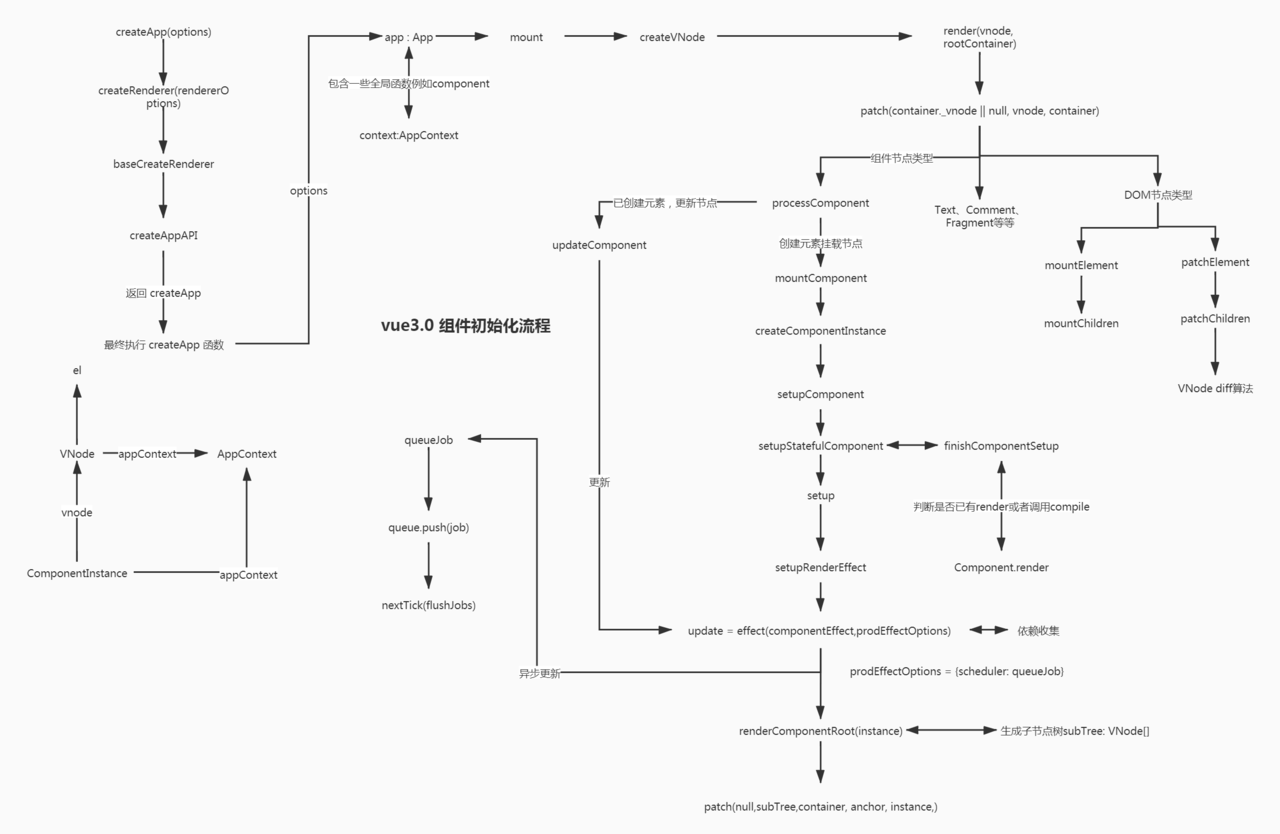彩蛋来了 写在前面,最近打算学习vue3.0 相关知识,本着学习一个东西,最好方法就是模仿写一个,所以自己动手写了一个简化版vue3.0,自己称作mini-vue3.0 感觉对vue3.0 或者 vue2.x核心原理的理解有很大帮助,所以分享出来。mini-vue3.0主要包括:模板编译、响应式、组件渲染过程等, 仓库地址mini-vue3.0,欢迎star
组件渲染原理
本文简单介绍vue3.0 组件的渲染过程,为了更好说明组件渲染原理,本文会结合一个简单的例子来说明整个过程。
简单一点渲染过程图

复杂一点渲染过程图

设挂载点为
<div id="app"></div>
复制代码根组件定义为
const rootComponent = {
template: `<div class="parent">
<div :class="data.class">组件渲染内容</div>
</div>`,
setup() {
// reactive 作用是设置数据响应式
const data = reactive({
class: 'demo'
})
return {
data
}
}
}
复制代码创建App全局上下文
首先创建App全局上下文,创建的上下文如下:
const appContext = {
mixins: [], // 存储全局mixins
components: {}, // 存储全局组件
directives: {}, // 存储全局指令
}
复制代码创建组件VNode
const rootVnode = {
type: rootComponent, // type的值可为字符串例如:div 或者 组件options对象
props: {},
children: {},
component: null, // 组件实例
appContext: appContext // 全局上下文,
}
复制代码appContext: 全局上下文中的全局组件、指令,会在render函数执行时候,生成组件VNode时,用于解析全局组件、指令 type: 如果是普通DOM元素,则为字符串;如果为组件节点则为组件定义对象。在我们例子,为一个组件定义对象
根据VNode渲染根组件
创建组件实例
根据组件VNode 初始化组件实例instance
const instance = {
vnode: rootVnode,// 组件vnode
parent: null,// 父组件实例,本文例子为null
appContext, // 全局上下文
type: rootVnode.type, // 节点类型
subTree: null, // 组件内渲染VNode树
render: null,
proxy: null,
data: {},
props: {},
setupState: {},
// 继承全局组件和指令
components: Object.create(appContext.components),
directives: Object.create(appContext.directives),
ctx: { _: instance }
}
复制代码ctx: 这个ctx 属性,是为了渲染模板的时候,将instance自身作为执行上下文
初始化组件实例相关属性
// 设置模板渲染render函数
const Component = instance.type // 组件options
if (!Component.render && Component.template && compile) {
// 编译模板为render函数
Component.render = compile(Component.template)
}
if (!Component.render) {
throw Error('请检查模板是否正确')
}
instance.render = Component.render
// 设置render 函数调用时的渲染上下文
instance.proxy = new Proxy(instance.ctx, {
get({ _: instance }, key) {
const { setupState } = instance
// setupState 优先
if (setupState[key] && hasOwn(setupState, key)) {
return setupState[key]
}
},
set({ _: instance }, key, val) {
const { setupState } = instance
if (setupState[key] && hasOwn(setupState, key)) {
setupState[key] = val
}
},
})
const { setup } = Component
// 调用setup函数
if (setup) {
const setupResult = setup()
// 这里设置响应式
instance.setupState = reactive(setupResult)
}
复制代码代码中compile 为编译函数,具体实现原理模板编译原理
根据本文的例子,得到render、setupState:
// _c 为创建VNode
instance.render = function () { return _c('div',
{class: "parent"},
[_c('div',
{class: this.data.class},
[_c('text', {value: '组件渲染内容'})]
)]
)
}
instance.setupState = {
dataProxy: {
class: 'demo'
}
}
复制代码渲染组件内容
// 渲染组件 effect 为响应式相关函数,用于依赖收集,并且设置了组件update的更新函数
// effect 等价于vue2.x 中的 Watcher
instance.update = effect(function componentEffect() {
// 渲染组件模板,得到组件子树VNode,同时完成依赖收集,instance.proxy 其实代理就是组件自生component
const subTree = (instance.subTree = instance.render.call(instance.proxy, instance.proxy))
// 根据组件子树VNode ,渲染组件内容
mountElement(subTree, container, anchor, instance)
rootVnode.el = subTree.el
instance.isMounted = true
})
// 根据VNode 创建具体 Dom元素
// container 父Dom 元素,在我们例子中为 id="app" 的元素
const mountElement = (vnode, container, anchor, parentComponent) => {
const { type, props, children } = vnode
let el
// 文本节点特殊处理
if (type === 'text') {
el = vnode.el = document.createTextNode(props.value)
} else {
el = vnode.el = document.createElement(type)
// 递归渲染挂载子树
if (children) {
mountChildren(vnode.children, el, null, parentComponent)
}
// 这里的 props 表示是Dom元素上的props
if (props) {
for (const key in props) {
el.setAttribute(key, props[key])
}
}
}
// 插入DOM中
document.appendChild(container, el, anchor)
}
复制代码本文例子中根组件 得到的subTree如下:
{
"type": "div",
"props": {
"class": "parent"
},
"children": [{
"type": "div",
"props": {
"class": "before"
},
"children": [{
"type": "text",
"props": {
"value": "组件渲染内容"
},
"component": null,
"appContext": null
}],
"component": null,
"appContext": null
}],
"component": null,
"appContext": null
}
复制代码



